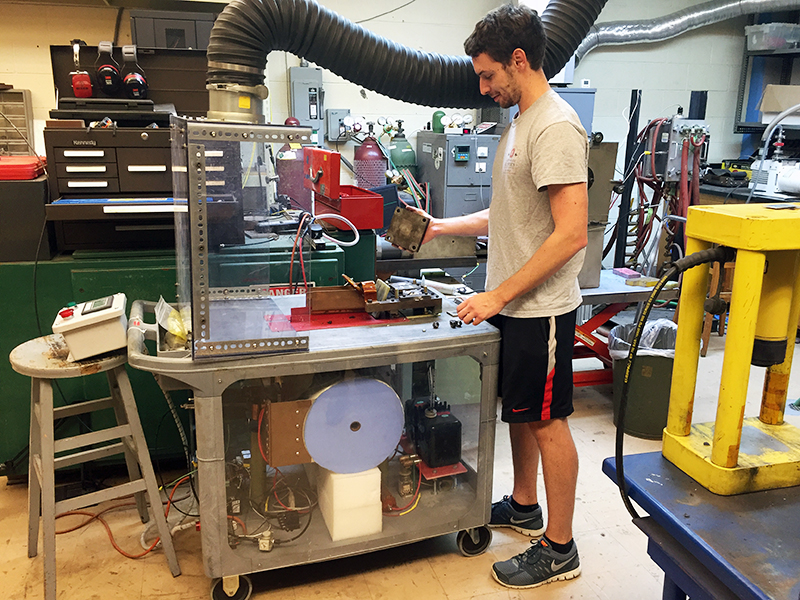
Scott Wright, fifth-year in materials science engineering demonstrates how the new welding technique is made. Credit: Lauren Holley / Lantern reporter
A team of engineers from Ohio State has developed a new welding technique that has the potential to change the automobile industry.
Anupam Vivek, the senior research associate working on the project, said the new type of welding used for the project is called solid-state welding, which uses electricity to weld materials using a very high-speed impact between two or more sheets of metal. This is different than the traditional welding technique, fusion-state welding, which uses heat to melt the materials.
The new welding technique uses 80 percent less energy with bonds created 50 percent stronger. Materials that usually cannot be welded in the traditional way are now weldable.
“Very few materials are nonweldable for us; almost everything we have tried, including ultra-high strength steels, have welded together, which traditionally is not possible,” Vivek said.
He said lighter materials will replace steel, which is used to make 90 percent of cars today, making their new welding technique important because the new technique is more capable of welding these lighter materials.
Vivek said the auto industry is hoping to reduce the weight of cars because of the new Environmental Protection Agency requirements, which state that by 2025, cars need to get 54 miles per gallon, about double what the average automobile gets now.
Bert Liu, a graduate research assistant working on the project, said an advantage of solid-state welding compared to fusion-state is that the bonds formed are much stronger.
“The heat used in fusion-based welding can actually weaken the material surrounding the weld,” Liu said. “This is something we can avoid by using solid-state welding.”
Vivek also said he understands that it will be challenging to commercialize the final outcome because of the high cost to replace the old technique with the new one.
“To make a change, the auto industry believes in this pyramid of cost, performance and time,” he said. “It has to be cost-neutral or cost-down, performance has to improve and it has to take less time.”
Vivek added that he is confident that they can make all three of those factors better to meet the needs of the auto industry.
The team is now working with I-Corp@Ohio, a training program under the Fisher College of Business, to help commercialize their research outcomes, actively seeking collaborations with major auto manufacturers and providers like Honda, Ford and General Motors.
Michael Camp, the program director of I-Corp@Ohio, said that the new welding technique has tremendous advantages from a technological standpoint.
“They’ve got a technology that is so advanced that the market is not even ready for it yet. It can do things the market is not even thinking about it yet … It’s that exciting,” Camp said.
Camp also said that it would be a challenge because their technology is too new to be commercialized.
“It’s hard to get people to do things so differently when they are not even aware that they need what you are providing,” he said. “It is going to take a while to find early adopters who want to work with them to get it to the point where the big companies can pick it up.”
Vivek said the effect on the auto industry could be huge because it solves an important, yet difficult, situation in the industry, which is still looking for a cost-effective answer.
Liu said this was just a small technology idea that started out in their lab, and he’s impressed with what they have been able to create, adding that he’s excited to have continued conversations and engagement with people within industry.
Assisted by I-Corp@Ohio, the team is interviewing hundreds of manufacturers in the industry, making a business plan that could better meet the needs of the auto industry as well as to maximize the market potential of the new technology.
Camp said that he believes making the research outcomes accessible to the industry is vital because research conducted in public research institutions like OSU are predominantly supported by public funding and tax money.
“We have a moral obligation to make sure that what we developed and invented is maximized to the value they add back to the society,” Camp said.


